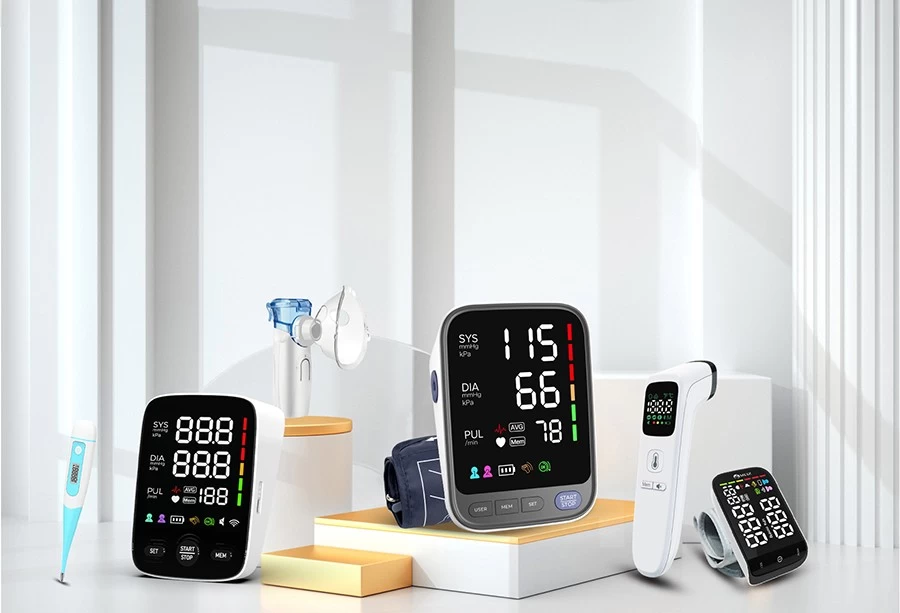Transforming Healthcare Delivery-Household Medical Devices
Release time:2025-06-20
Household Medical Devices: Transforming Healthcare Delivery
1. Introduction
In an era marked by rapid technological advancements and shifting demographic landscapes, household medical devices have emerged as a pivotal component of modern healthcare. These devices, designed to monitor, treat, or assist with medical conditions within the comfort of home environments, are revolutionizing how individuals manage their health. From simple blood pressure monitors to sophisticated robotic exoskeletons, household medical devices cater to a wide spectrum of needs, ranging from chronic disease management to post-surgical rehabilitation.
The global healthcare landscape is undergoing significant transformations, driven by factors such as an aging population, the rising prevalence of chronic diseases, and the growing demand for cost-effective healthcare solutions. According to the World Health Organization (WHO), by 2050, the number of people aged 60 years and above will double, reaching 2.1 billion, accounting for 22% of the world's population. This demographic shift has led to a surge in chronic conditions like diabetes, cardiovascular diseases, and respiratory disorders, which often require long-term management. Household medical devices offer a practical solution by enabling patients to monitor their health status regularly, adhere to treatment plans, and reduce the frequency of hospital visits.
2. Definition and Classification of Household Medical Devices
Household medical devices can be defined as any equipment, instrument, or apparatus intended for use in the home setting to diagnose, prevent, monitor, treat, or alleviate a medical condition. These devices are designed to be user-friendly, safe, and effective, even when operated by non-professional caregivers or patients themselves. They can be classified into several categories based on their primary function:
2.1 Monitoring Devices
These devices are used to track vital signs and health parameters. Examples include:
- Blood Pressure Monitors: Automatic cuff-based devices that measure systolic and diastolic blood pressure. Modern models often come with Bluetooth connectivity, allowing users to sync data with mobile apps for long-term tracking.
- Glucose Meters: Portable devices used by diabetics to measure blood glucose levels. Continuous Glucose Monitoring (CGM) systems, which provide real-time glucose data through a small sensor inserted under the skin, are becoming increasingly popular.
- Pulse Oximeters: Non-invasive devices that measure blood oxygen saturation and pulse rate, commonly used by individuals with respiratory conditions or during sleep monitoring.
2.2 Treatment Devices
These devices deliver therapeutic interventions at home:
- Nebulizers: Convert liquid medication into a fine mist that can be inhaled, used for treating asthma, chronic obstructive pulmonary disease (COPD), and other respiratory disorders.
- Insulin Pumps: Small, wearable devices that deliver insulin continuously or in bolus doses, providing better control over blood glucose levels for diabetics.
- CPAP/BiPAP Machines: Used to treat sleep apnea by delivering a constant or bi-level stream of air to keep the airways open during sleep, improving sleep quality and reducing the risk of cardiovascular complications.
2.3 Rehabilitation and Assistive Devices
These devices aid in physical rehabilitation and enhance mobility:
- Mobility Aids: Such as canes, walkers, and wheelchairs, which assist individuals with mobility impairments. Advanced models include electric wheelchairs with intelligent navigation systems.
- Rehabilitation Equipment: Physical therapy devices like knee and ankle braces, hand exercisers, and treadmill desks, which help patients regain strength and functionality after injuries or strokes.
- Robotic Exoskeletons: Emerging technology that enables individuals with spinal cord injuries or lower limb paralysis to stand and walk by providing mechanical support to the legs.
2.4 Diagnostic Devices
While less common in the home setting, some basic diagnostic devices are becoming more accessible:
- Thermometers: Digital thermometers that accurately measure body temperature, with options for oral, rectal, or forehead use.
- ECG Monitors: Portable electrocardiogram devices that can detect heart rhythm abnormalities, allowing users to share data with healthcare providers remotely.
3. Drivers of Growth in Household Medical Devices
3.1 Aging Population and Chronic Disease Burden
As mentioned earlier, the aging population is a key driver for the growth of household medical devices. Older adults are more likely to suffer from multiple chronic conditions, which require ongoing management. For example, in the United States, 85% of older adults have at least one chronic disease, and 60% have two or more. Chronic diseases account for 75% of healthcare spending in the country, making cost-effective home-based care a priority. Household medical devices allow patients to manage their conditions proactively, reducing the need for expensive hospitalizations and emergency visits.
3.2 Technological Advancements
The rapid development of technologies such as the Internet of Things (IoT), sensors, artificial intelligence (AI), and miniaturization has revolutionized household medical devices. IoT-enabled devices can collect and transmit real-time health data to healthcare providers, enabling remote monitoring and timely interventions. AI algorithms can analyze large amounts of data to detect patterns and predict health risks. For instance, AI-powered glucose monitors can predict hypoglycemic or hyperglycemic episodes in diabetics and send alerts to both the patient and their healthcare team. Miniaturization has made devices more portable and user-friendly, such as the small size of modern insulin pumps and CGM sensors.
3.3 Rising Healthcare Costs
Healthcare costs have been escalating globally, driven by factors such as new medical technologies, an aging population, and the complexity of treating chronic diseases. Household medical devices offer a cost-effective alternative to institutional care. For example, a study by the National Institute for Health and Care Excellence (NICE) in the UK found that home-based pulmonary rehabilitation using remote monitoring devices reduced hospital readmissions and saved an average of £1,200 per patient compared to traditional hospital-based rehabilitation.
3.4 Changing Patient Preferences
Patients are increasingly seeking more convenient and personalized healthcare solutions. Home-based care allows individuals to receive treatment in a familiar and comfortable environment, reducing stress and improving quality of life. Additionally, the availability of user-friendly devices and mobile health apps has empowered patients to take an active role in their healthcare, promoting better adherence to treatment plans and health behaviors.
4. Benefits of Household Medical Devices
4.1 Improved Patient Outcomes
By enabling continuous monitoring and timely interventions, household medical devices can significantly improve patient outcomes. For example, in patients with heart failure, home-based monitoring of weight, blood pressure, and symptoms using wireless devices has been shown to reduce hospital readmissions by 30-50%. Similarly, CGM systems have been associated with better glycemic control and a reduction in hypoglycemic events in diabetics.
4.2 Enhanced Quality of Life
Assistive and rehabilitation devices play a crucial role in enhancing the quality of life for individuals with disabilities or mobility impairments. Robotic exoskeletons, for instance, allow paraplegic patients to stand and walk, improving their physical and psychological well-being. Mobility aids enable older adults to maintain their independence and participate in daily activities, reducing the risk of social isolation.
4.3 Cost Savings for Healthcare Systems
As mentioned earlier, household medical devices can lead to significant cost savings by reducing hospital visits and length of stay. A report by Grand View Research estimated that the global home healthcare market, which includes household medical devices, will reach $406.6 billion by 2027, growing at a compound annual growth rate (CAGR) of 6.2%. This growth is driven by the cost-effectiveness of home-based care compared to institutional settings.
4.4 Empowerment of Patients and Caregivers
Household medical devices empower patients to take control of their health by providing them with real-time data and tools for self-management. They also reduce the burden on caregivers, as many devices are designed to be easy to use and require minimal supervision. For example, smart pill dispensers can remind patients to take their medications and send alerts to caregivers if a dose is missed, ensuring medication adherence without constant monitoring.
5. Challenges in Household Medical Devices
5.1 Regulatory and Safety Concerns
Ensuring the safety and efficacy of household medical devices is a major challenge. Different countries have varying regulatory standards, which can complicate the global market for manufacturers. For example, in the United States, the Food and Drug Administration (FDA) regulates medical devices, while the European Union has the Medical Device Regulation (MDR). Manufacturers must comply with these regulations, which can be costly and time-consuming. Additionally, the rapid development of new technologies has outpaced regulatory frameworks in some areas, raising concerns about the safety of emerging devices like AI-powered health monitors.
5.2 Technological Barriers
While technological advancements have improved the functionality of household medical devices, they have also introduced new challenges. Many devices require a certain level of technical literacy to operate, which can be a barrier for older adults or individuals with limited digital skills. For example, setting up a Bluetooth-enabled blood pressure monitor and syncing it with a mobile app may be daunting for some users. Additionally, issues with data connectivity, such as poor Wi-Fi signals or device malfunctions, can disrupt the monitoring and treatment process.
5.3 Cost and Accessibility
Although household medical devices can lead to long-term cost savings, the initial cost of some devices can be prohibitive, especially for low-income individuals or those without adequate health insurance. For example, a robotic exoskeleton can cost upwards of $100,000, making it inaccessible to many patients. Additionally, in some regions, especially developing countries, the availability of household medical devices is limited due to poor healthcare infrastructure and lack of awareness.
5.4 Data Privacy and Security
With the increasing connectivity of household medical devices, data privacy and security have become major concerns. These devices collect sensitive health data, which can be vulnerable to cyberattacks or unauthorized access. For example, a breach in a CGM system's data could expose a patient's glucose levels, which could be used for malicious purposes. Ensuring the security of these systems and protecting patient data is crucial to maintaining trust in household medical devices.
6. Future Trends in Household Medical Devices
6.1 Integration with Telehealth and Remote Monitoring
The COVID-19 pandemic has accelerated the adoption of telehealth, and household medical devices are expected to play a key role in this trend. Integration with telehealth platforms will allow healthcare providers to remotely monitor patients' health status, adjust treatment plans, and provide timely interventions. For example, a patient with COPD using a home nebulizer and a pulse oximeter can have their data automatically transmitted to their doctor, who can then assess the need for a change in medication or a hospital visit.
6.2 Development of Smart and Connected Devices
The future of household medical devices lies in smart, connected devices that can interact with each other and with healthcare systems. These devices will be equipped with advanced sensors, AI algorithms, and machine learning capabilities to provide personalized care. For example, a smart home ecosystem could include a scale that monitors weight, a blood pressure monitor, and a glucose meter, all of which send data to a central hub that uses AI to analyze the data and provide health recommendations.
6.3 Focus on Preventive Healthcare
As the healthcare industry shifts from a disease-treatment model to a preventive healthcare model, household medical devices will increasingly be used for early detection and prevention of diseases. For example, wearable devices that monitor heart rate, sleep patterns, and activity levels can detect early signs of health problems and encourage users to adopt healthier lifestyles. Genetic testing kits and home-based diagnostic devices that can detect early-stage cancer or other diseases are also expected to become more prevalent.
6.4 Advancements in Materials and Design
New materials such as flexible electronics, biodegradable sensors, and nanomaterials will enable the development of more comfortable, lightweight, and durable household medical devices. For example, flexible glucose sensors that can be worn like a patch and biodegradable implants that dissolve after delivering medication are already in the research and development stage. These advancements will improve user comfort and compliance, making it easier for individuals to incorporate these devices into their daily lives.
7. Conclusion
Household medical devices have come a long way from simple thermometers and blood pressure monitors to sophisticated, connected systems that are transforming healthcare delivery. They offer numerous benefits, including improved patient outcomes, enhanced quality of life, cost savings, and patient empowerment, while also facing challenges such as regulatory issues, technological barriers, cost, and data privacy.
As the global population ages and the burden of chronic diseases continues to grow, the demand for household medical devices is expected to rise exponentially. Technological advancements, combined with changing healthcare needs and patient preferences, will drive the development of more innovative, user-friendly, and cost-effective devices. The future of household medical devices lies in their integration with telehealth, the development of smart and connected systems, a focus on preventive healthcare, and advancements in materials and design.
While challenges remain, the potential of household medical devices to revolutionize healthcare and improve the lives of millions of people around the world is undeniable. Continued investment in research and development, along with clear regulatory frameworks and initiatives to improve accessibility, will be essential to realizing this potential and creating a more patient-centered, efficient healthcare system.
Just for you
Send Inquiry









